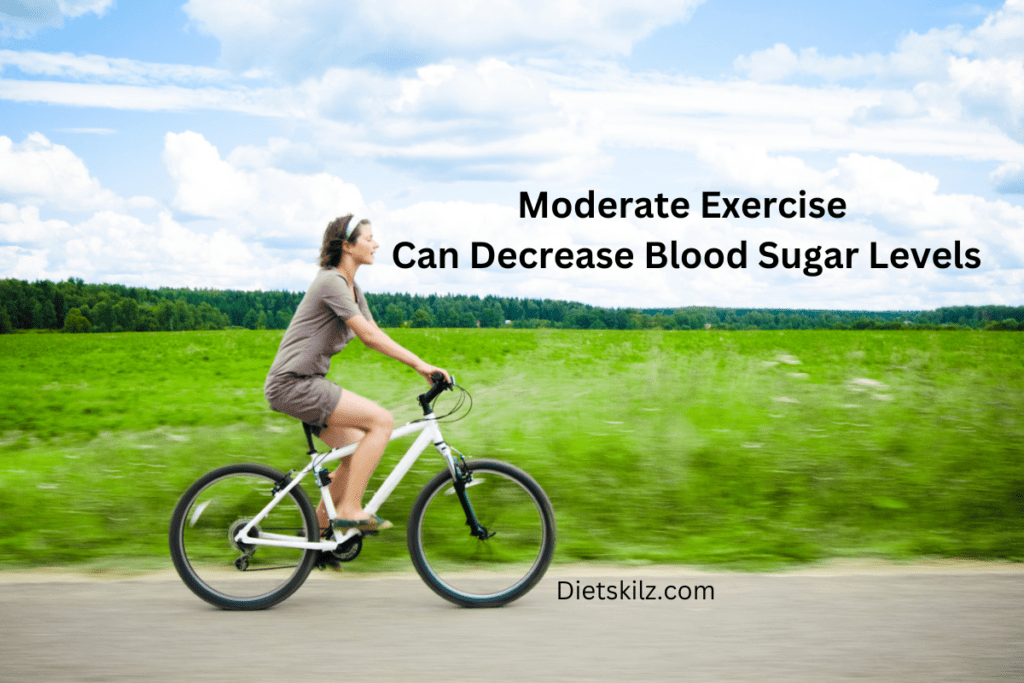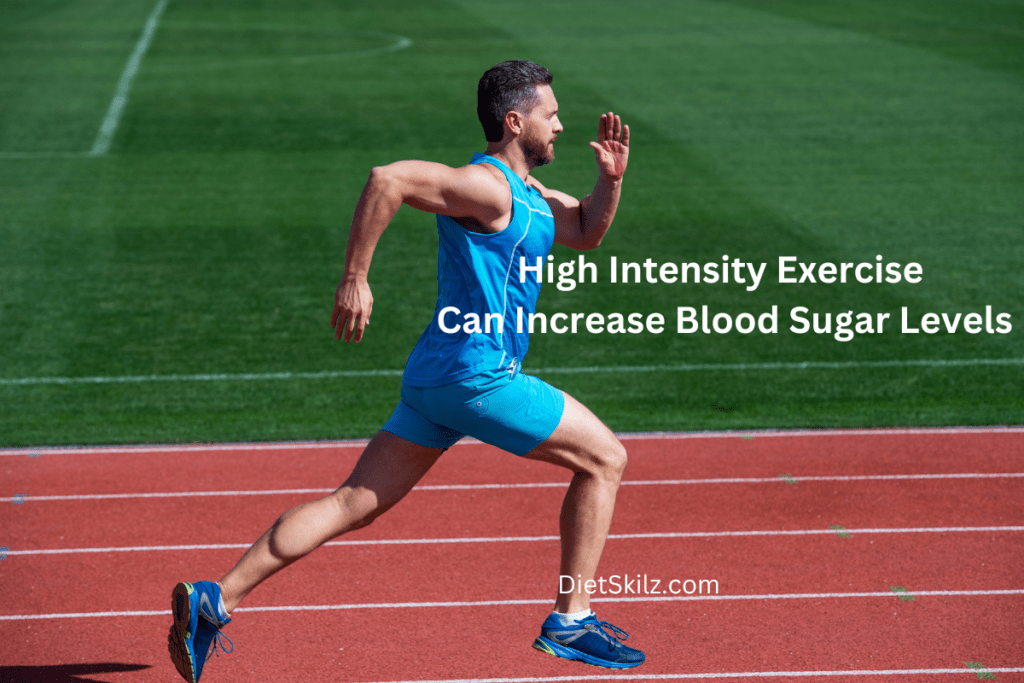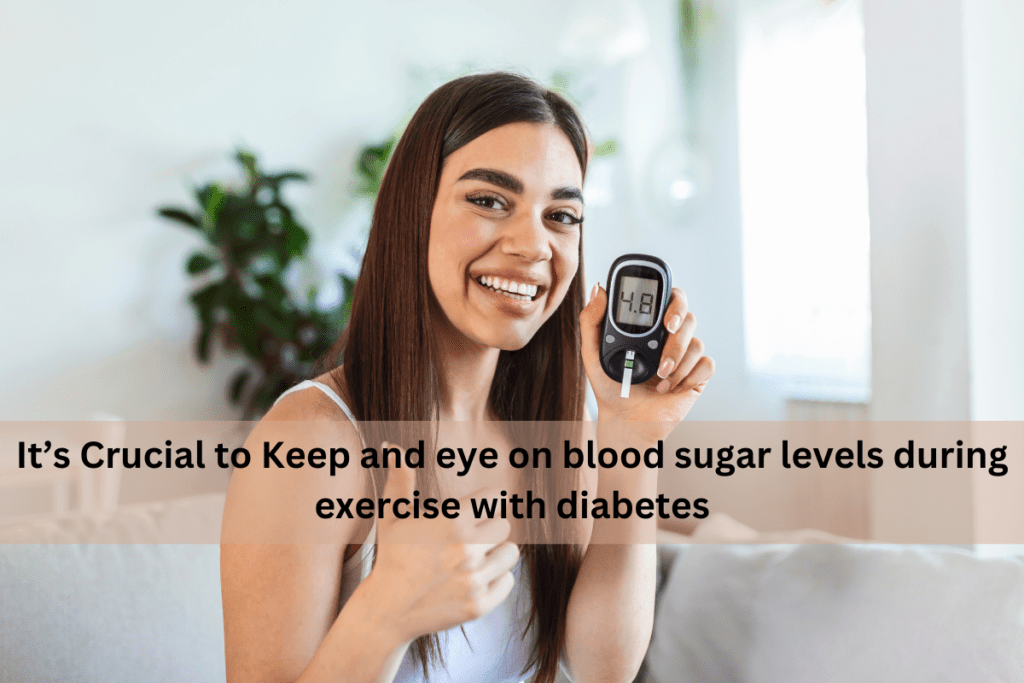Exercise plays a crucial role in managing blood sugar levels, with its effects varying based on the type, intensity, and duration of the activity.
How does exercise affect blood sugar levels?
Aerobic exercises, like jogging or cycling, typically lower blood glucose by enhancing insulin sensitivity and allowing muscles to absorb glucose more efficiently.
In contrast, anaerobic activities, such as heavy weightlifting, may temporarily raise blood sugar due to the release of stress hormones.
Over time, consistent exercise improves overall glucose metabolism and insulin sensitivity, highlighting the importance of regular physical activity in blood sugar management.
Exercise has a complex and multifaceted effect on blood sugar levels, influenced by various factors such as the type, intensity, and duration of physical activity.
Understanding these dynamics can help individuals, especially those with diabetes, tailor their exercise routines for optimal blood glucose control.
How Does Exercise Affect Blood Sugar Levels?
There’s a lot of information in this post about blood sugar levels, which are important to your best life, as well as getting the most from your exercise and weight loss goals, by helping you maintain energy and avoid crashes. So, read on, and make your observations, questions, and comments in the comments section at the bottom.
Exercise’s Complex Effect on Blood Sugar Levels
The impact of physical activity on blood sugar happens in multiple ways, depending on factors like the type, intensity, and duration of physical activity. Different forms of exercise have distinct immediate and long-term effects on how the body processes glucose.
Immediate Effects of Exercise on Blood Sugar Levels
Understanding how does exercise affect blood sugar is crucial for managing glucose levels effectively.
Aerobic Exercise

Moderate-intensity aerobic activities such as walking, jogging, or cycling typically lead to a decrease in blood glucose levels. This happens because:
- Muscles use glucose for energy during exercise: The body taps into glucose reserves to fuel the working muscles, ensuring a steady energy supply during sustained activity.
- Insulin sensitivity increases: Exercise and insulin sensitivity is enhanced with the body’s ability to use insulin more effectively, allowing cells to absorb glucose from the blood, which helps lower overall blood sugar levels.
- Muscles can absorb glucose without insulin during contraction: During aerobic exercise, muscles can uptake glucose directly, bypassing the usual insulin-mediated pathway, making it an effective way to reduce blood sugar.
Anaerobic Exercise
High-intensity exercises like sprinting or heavy weightlifting can temporarily raise blood sugar levels. This occurs due to:

- The release of stress hormones: Hormones such as adrenaline and cortisol are released during high-intensity exercise, prompting the liver to release glucose into the bloodstream, providing a quick energy surge.
- The body’s fight-or-flight response: This physiological reaction increases blood sugar to provide quick energy for intense physical exertion, ensuring that muscles have enough fuel for sudden bursts of activity.
Long-Term Effects of Exercise on Blood Sugar Levels
Regular physical activity demonstrates “how exercise affects blood sugar” over time, leading to improved insulin sensitivity.
Regular exercise has significant long-term benefits for blood sugar management:
- Improved insulin sensitivity: The positive effects of exercise on insulin sensitivity can last for 24-72 hours after a workout, making it easier for cells to absorb glucose, thereby reducing the risk of chronic high blood sugar.
- Lower A1C levels: Over time, consistent physical activity can lead to reduced A1C levels, a key marker for long-term blood sugar control, which is crucial for preventing complications related to diabetes.
- Enhanced glucose metabolism: Regular exercise improves the body’s overall ability to process and use glucose, reducing the risk of insulin resistance and type 2 diabetes, thereby promoting overall metabolic health.
Factors That Influence Blood Sugar During Exercise
Various factors can influence the affect blood sugar has on your exercise routine, including pre-exercise glucose levels and fitness status.
Several factors can affect how exercise influences blood sugar levels:
- Pre-exercise blood glucose: Initial blood sugar levels can determine the extent of the blood sugar levels after exercise, with higher starting levels typically resulting in more significant reductions.
- Exercise timing: Morning workouts may be affected by the dawn phenomenon, a natural rise in blood sugar levels in the early hours due to hormonal changes, which can alter the body’s response to exercise.
- Fitness level: Fitter individuals often experience smaller fluctuations in blood sugar levels during exercise compared to those who are less fit, as their bodies are better adapted to efficiently manage glucose.
- Diabetes status: People with diabetes may have different blood sugar responses to exercise, requiring careful monitoring and management to avoid potential hypo- or hyperglycemia during physical activity.
Managing Blood Sugar With Diabetes During Exercise

For individuals with diabetes, it’s crucial to manage blood sugar levels carefully during physical activity:
- Check blood glucose levels before, during, and after exercise: This helps in understanding how exercise affects their blood sugar and prevents extreme highs or lows, allowing for more controlled and safe workouts.
- Be prepared to treat hypoglycemia: Carrying fast-acting carbohydrates, like glucose tablets, can help quickly address low blood sugar if it occurs, preventing potentially dangerous situations.
- Consult healthcare providers: Adjusting medication or carbohydrate intake around workout times might be necessary to maintain optimal blood sugar control, ensuring that exercise remains beneficial without causing adverse effects.
How Do Blood Sugar Levels Affect Exercise?
Did you know that your blood sugar levels can significantly impact your workouts? Understanding how blood sugar fluctuates during physical activity can help you optimize your performance and ensure your safety. Let’s dive into the relationship between blood sugar levels and exercise, and why maintaining optimal levels is crucial for effective physical performance.
Immediate Effects of Blood Sugar Levels on Exercise
Low Blood Sugar (Hypoglycemia)
When your blood sugar levels drop too low during exercise, you may experience symptoms such as dizziness, fatigue, confusion, and even fainting. These symptoms can drastically affect your ability to continue your workout and pose serious safety risks. Ensuring your blood sugar stays within a safe range is key to avoiding these dangerous situations.
High Blood Sugar (Hyperglycemia)
On the flip side, high blood sugar levels during exercise can lead to symptoms like increased thirst, headaches, and blurred vision. Exercising with elevated blood sugar can strain your body and, in extreme cases, may lead to complications such as diabetic ketoacidosis (DKA), especially for those with diabetes. Managing your blood sugar before engaging in physical activity is vital to prevent these adverse effects.
Blood Sugar Fluctuations During Different Types of Exercise
Aerobic Exercise
Aerobic activities such as walking, jogging, or cycling typically lower your blood sugar levels. This happens because your muscles use glucose for energy, increasing insulin sensitivity and allowing cells to absorb glucose more efficiently. During muscle contractions, glucose can be absorbed even without insulin, making aerobic exercise an effective way to reduce blood sugar levels.
Anaerobic Exercise
In contrast, high-intensity exercises like sprinting or heavy weightlifting may cause a temporary rise in your blood sugar levels. This is due to the release of stress hormones like adrenaline, which stimulates your liver to release glucose into your bloodstream. Your body’s fight-or-flight response ensures that you have enough energy for sudden, intense activity, but this can lead to higher glucose levels during and shortly after anaerobic exercise.
Long-Term Impact of Exercise on Blood Sugar Control
Regular Exercise Benefits
Consistent exercise offers lasting benefits for blood sugar management. Regular physical activity improves insulin sensitivity for up to 24-72 hours post-workout, making it easier for your body to regulate blood glucose. Over time, this can lead to lower A1C levels, a critical marker of long-term blood sugar control. Additionally, exercise enhances your overall glucose metabolism, reducing the risk of developing insulin resistance and type 2 diabetes.
Exercise as a Preventative Measure
By incorporating regular exercise into your routine, you can significantly reduce the risk of insulin resistance and type 2 diabetes. Exercise not only helps in managing current blood sugar levels but also acts as a preventative measure to maintain overall metabolic health.
Factors That Influence Blood Sugar Response to Exercise
Pre-Exercise Blood Sugar Levels
Your starting blood sugar levels can greatly influence how your body responds to exercise. If your levels are too high or too low, it can affect the magnitude of change during and after your workout. Monitoring your blood sugar before you begin exercising can help you anticipate these changes and adjust your routine accordingly.
Exercise Timing
The timing of your workouts can also impact your blood sugar response. Morning workouts, for instance, may be affected by the dawn phenomenon, a natural rise in blood sugar levels due to hormonal changes. Understanding how your body reacts at different times of the day can help you plan your exercise sessions more effectively.
Individual Fitness Levels
Your fitness level plays a role in how your blood sugar fluctuates during exercise. Fitter individuals often experience smaller fluctuations because their bodies are better adapted to efficiently manage glucose. As your fitness improves, you may notice more stable blood sugar levels during workouts.
Diabetes Status
If you have diabetes, your blood sugar response to exercise may differ from those without the condition. You’ll need to carefully monitor and manage your blood sugar to avoid hypo- or hyperglycemia during physical activity. Consulting with your healthcare provider can help tailor your exercise plan to suit your needs.
Managing Blood Sugar Levels for Optimal Exercise Performance
Blood sugar levels play a significant role in your exercise performance and safety. By understanding how your body responds to different types of exercise and blood sugar regulation, you can optimize your workouts and maintain your overall health. Regular monitoring, personalized strategies, and adjustments based on your individual needs will help you harness the full benefits of physical activity while keeping your blood sugar in check.
Monitoring Blood Sugar
Checking your blood sugar levels before, during, and after exercise is crucial for understanding how your body responds to physical activity. This practice helps you avoid extreme highs or lows and ensures a more controlled and safe workout.
Adjusting Diet and Medication
Balancing your food intake and medication around your workouts can help maintain optimal blood sugar levels. Consuming the right amount of carbohydrates and possibly adjusting your medication under your healthcare provider’s guidance can enhance your exercise performance.
Preparing for Hypoglycemia
Always be prepared to treat low blood sugar during exercise. Carrying fast-acting carbohydrates, like glucose tablets or snacks, can quickly address hypoglycemia, ensuring your safety and allowing you to continue your workout without interruptions.
How Do Blood Sugar Levels Affect Weight Loss Goals?
When you’re working towards your weight loss goals, blood sugar levels can play a significant role in your success. Understanding the connection between blood sugar and weight management is key to achieving long-term results. Let’s explore how maintaining stable blood sugar levels can help you stay on track with your weight loss journey.
The Role of Blood Sugar in Metabolism
Blood sugar levels play a crucial role in how your body manages its energy needs. By understanding this relationship, you can see how fluctuations in blood sugar can influence your metabolism and, in turn, your ability to achieve your weight loss goals.
Blood Sugar and Energy Utilization
Your blood sugar levels directly influence how your body uses energy. Glucose, the sugar in your blood, is your body’s primary energy source. When you eat, your body breaks down carbohydrates into glucose, providing fuel for your cells. Stable blood sugar levels ensure a steady supply of energy, helping you stay active and burn calories efficiently.
Insulin’s Role in Fat Storage
Insulin, a hormone released by your pancreas, helps regulate blood sugar levels by allowing glucose to enter your cells. However, frequent spikes in blood sugar can lead to increased insulin production. High insulin levels promote fat storage, particularly around your belly. By keeping your blood sugar steady, you can prevent excessive insulin release and reduce the likelihood of storing excess fat.
Blood Sugar Fluctuations and Appetite Control
High Blood Sugar Levels
When your blood sugar levels are high, you may experience increased hunger and cravings. This is because the excess glucose is quickly absorbed, leading to a rapid drop in blood sugar, which triggers hunger signals. These cycles of spikes and crashes can make it harder for you to control your appetite and stick to a healthy eating plan.
Low Blood Sugar Levels
On the other hand, when your blood sugar drops too low, you might feel fatigued, dizzy, and crave sugary or high-carb foods to boost your energy. This can lead to overeating and making unhealthy food choices, derailing your weight loss efforts. Maintaining balanced blood sugar helps you avoid these extreme fluctuations and keeps your hunger in check.
Impact of Blood Sugar Stability on Weight Loss
Steady Blood Sugar and Fat Burning
Keeping your blood sugar levels stable enhances your body’s ability to burn fat. When glucose is consistently available in moderate amounts, your body is less likely to store it as fat and more likely to use it for energy. This steady supply supports fat oxidation, which is crucial for weight loss.
Blood Sugar Balance and Satiety
Balanced blood sugar levels also contribute to a feeling of fullness or satiety. When your blood sugar remains stable, your body releases hormones that signal satiety, helping you avoid overeating. This makes it easier to control portion sizes and maintain a calorie deficit, which is essential for weight loss.
Strategies to Maintain Stable Blood Sugar for Weight Loss
Diet and Nutrition
One of the most effective ways to stabilize your blood sugar is through your diet. Focus on eating low-glycemic index foods, which are digested more slowly and cause a gradual rise in blood sugar. Incorporating plenty of fiber and protein into your meals can also help stabilize your blood sugar and keep you feeling full longer.
Regular Exercise
Physical activity is another powerful tool for regulating blood sugar. Exercise helps your muscles use glucose for energy, which lowers blood sugar levels. Combining aerobic exercises, like walking or cycling, with strength training can maximize the benefits. Regular workouts can help improve your insulin sensitivity, making it easier for your body to manage glucose levels.
Monitoring and Lifestyle Changes
Regularly monitoring your blood sugar levels can give you valuable insights into how your body responds to different foods and activities. Making lifestyle changes, such as eating smaller, more frequent meals and managing stress, can also help keep your blood sugar stable. These adjustments support your overall weight loss goals by promoting better blood sugar control.
Special Considerations for Individuals with Diabetes
Weight Loss Challenges for Diabetics
If you have diabetes, managing your blood sugar while trying to lose weight can be more challenging. You may experience greater fluctuations in blood sugar, which can affect your hunger and energy levels. However, with careful planning, you can still achieve your weight loss goals.
Personalized Strategies
It’s essential to work closely with your healthcare provider to develop a personalized plan that fits your needs. This may include adjusting your medication, planning your meals, and incorporating regular physical activity. With the right strategies, you can manage your blood sugar effectively while working towards your weight loss goals.
Conclusion
Blood sugar levels significantly impact your weight loss efforts. By maintaining stable blood sugar, you can enhance your energy levels, control your appetite, and improve your body’s ability to burn fat. Implementing dietary changes, regular exercise, and lifestyle adjustments will help you manage your blood sugar and support your weight loss journey.
Remember, consistency is key, and understanding how does exercise affects blood sugar will empower you to achieve lasting results. By recognizing the affects of blood sugar, you can tailor your approach to physical activity and nutrition, optimizing your weight loss strategy and overall health.
